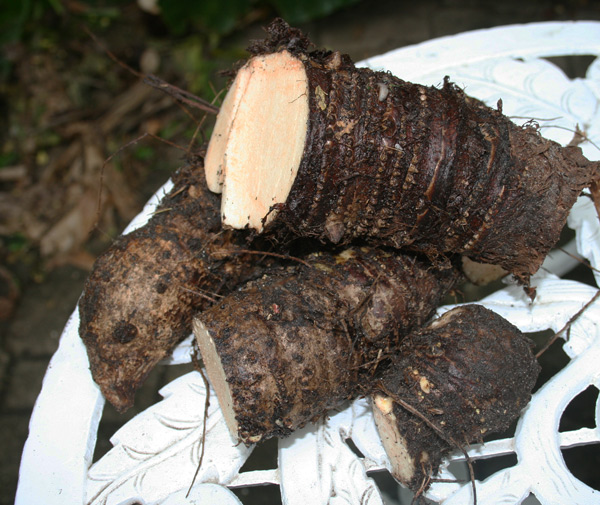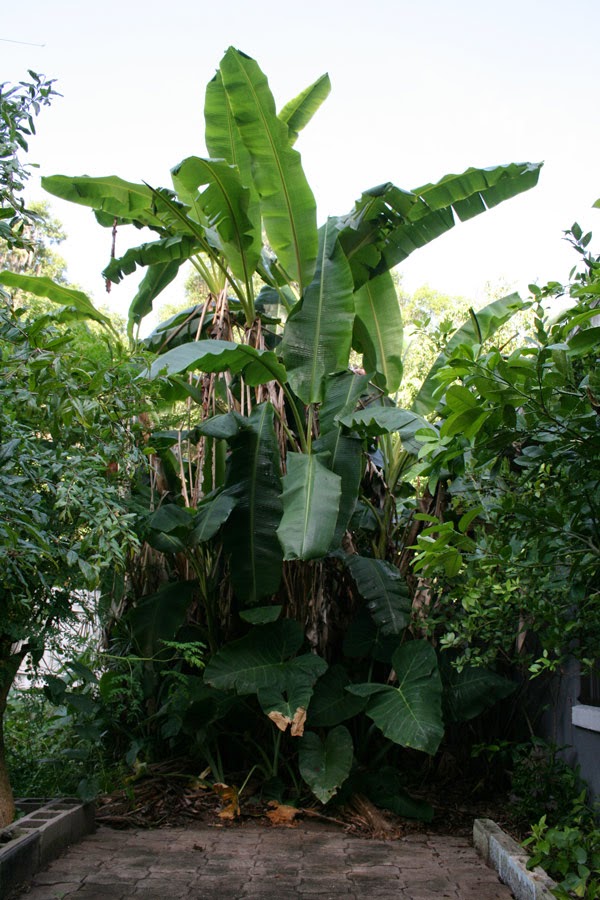Malanga is a tasty little root from the tropics. The plants are a close relative of the ornamental elephant ears grown in landscaping and they look much the same, though a little smaller.
The central roots and the side roots are edible – just toss a good bulb back in the ground when you harvest and you’ll have more the next year.
Malanga is a bunching perennial that is easy to grow and divide. They enjoy a lot of water and can even grow right in a ponds without rotting. My best-looking malanga plants are growing in The Greywater Oasis by my back patio. That’s where the roots above came from.
A couple of days later I boiled these, then stir-fried them with rice, eggs, fresh greens, kidney beans and some curry.
Excellent!
If you’re interested in growing malanga, go hit your local ethnic market and buy some good-looking roots, then plant them. That’s how I did mine and I’ve now had them growing for years.
The ones above were simply stuck in the ground beneath the banana trees as seen here:
Anyone else growing malanga?
Support this site: shop on Amazon using this link. It doesn’t cost you a penny and it helps pay for my hosting!




11 comments
I have malanga and edible taro growing. Both from store bought roots!
I have what I think are malanga but I haven't taken them to be positively identified yet. Malanga are yummy!
Yes. If you get the wrong thing, it'll burn your mouth. I have a friend who mixed up taro and malanga once. Once.
I am but mine have not done well because they don't get enough water. Maybe I will move mine closer to my banana trees at the back of the yard. Yours look beautiful! Lyda
I grew up on the island of Trinidad, and one of the dishes that is a staple of the island is Callaloo. It is a soup I guess you would have to say, made from “dasheen” leaves, ocra and pumpkin with blue crabs. I have lived in Florida for 29 years, and I miss my callaloo. I would love to plant some “dasheen” to get the leaves and in trying to determine what the name of that ground provision would be here in Florida, I came up based on my internet research with both malanga and taro. Yet I am seeing here that one of the commenters speaks of mixing up taro and malanga. I thought they were the same thing, so now I am confused?
Any help on determining whether “dasheen” is in fact malanga would be more than greatly appreciated.
This family is a big confusing mess. I usually just stick to malanga since it grows in drier soil and doesn’t require swampy conditions like taro. It is definitely good for callaloo soup. The local names are also a problem since they often differ from country to country. “Dasheen” may be taro in one place and malanga in another, just as in Jamaica callaloo is actually made from amaranth, not dasheen. You will be fine with malanga roots, though!
I am currently following a you tuber who started the growing process from tubers wrapped in wet paper towels and stuck into zip lock bags. Been in there a couple of days. My hope is to transfer them to indoor pots once they start growing, and then transfer outside in the spring. Never done this before. Anyone know if I am on the right track or not?
[…] like malanga, yams, turmeric and gingers are usually available – and sometimes rarities like the Chinese […]
I saw a video of someone harvesting and transplanting the malanga plants, I was wondering if they produce root and can be harvested again? Or does removing the malanga kill the plant. Sorry if a silly question, but I’m totally new to growing. Excited to get some Cuban malanga from our yard! Thanks for writing this!
We stopped by the Publix near the Homesteader’s event on the way back home and I bought some Malanga roots. I started to buy Yuca as well but wanted to research it a bit more first. I’m a bit confused on how to orient thes ewhen I plant them. In your video, you used cuttings of roots and I’ve read several different articles as well. Some of them say to plant the tuber pointed end up. Is that right? I could always just put them in a bag with moist coconut coir, I suppose, and plant them later after they sprout.
We planted some Cuban malangas but after harvesting the main (center) tuber, we had to call poison control from the pain and needles in our mouth! We were told the main tuber shouldn’t be eaten but the smaller side ones are what we are used to seeing in stores.
Comments are closed.